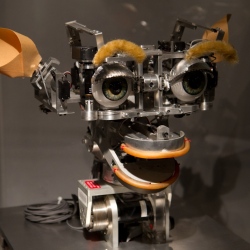
Most industrial robots are far less friendly than the Roomba robot vacuum cleaner, which is safe enough to be a surprisingly popular means of feline transportation. Industrial robots often sit behind metal fences, their mechanical arms a blur of terrific speed and precision. To prevent injury to humans, robots are shut down when anyone enters their workspace.
In recent years, however, the fences have started to disappear as a gentler breed of robot has entered the workplace and new features have made even conventional industrial robots safer to be around. This shift is altering the dynamics of labor in many factories and workshops, allowing humans and robots to work together in efficient new ways.
Human-robot collaboration is “gaining an enormous amount of momentum,” says Henrik Christensen, executive director of the Institute for Robotics and Intelligent Machines at Georgia Tech. “In the past, robots have penetrated 10 percent of the industry. There’s still 90 percent of the industry, and that’s where you need collaborative robots.”
The Robotic Industries Association, a U.S. trade group, last week organized its first conference dedicated to collaborative robots, at which robot manufacturers and customers gathered to discuss the trend. Christensen was a keynote speaker.
